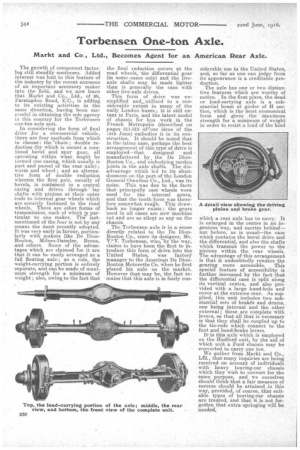Torbensen One-ton Axle.
Page 18

If you've noticed an error in this article please click here to report it so we can fix it.
Markt and Co, Ltd., Becomes Agent for an American Rear Axle.
The growth of component factoring still steadily continues. Added interest was lent to this feature of the industry by the recent entrance of an important accessory maker into the field, and -es now learn that Markt and Co., Ltd., of 98, Farringdon Road, E.C., is adding to its existing activities in the same direction, having been successful in obtaining the sole agency in this country for the Torbensen one-ton axle unit.
In considering the form of final drive for a commercial vehicle, there are four methods from which to choose : the 'chain ; double reduction (by which is meant a combined .bevel and spqr gear, all operating within what might be termed one casing, which usually is part and parcel of the rear axle); worm and wheel ; and an alternative form of double reduction wherein the first pair, usually of bevels, is •controined in a central casing and drives through ' lay shafts with pinions at their outer ends to internal gear wheels which are securely fastened to the road wheels. There are other forms of transmission, each ef which is particular to one maker. The lastmentioned of the four is not by any Means the most recently adopted. It was very early in favour, particularly with makers like De DionBouton, 141ilnes-Daimler, Berm, and others. Some of the advantages which are claimed for it are that it can be easily arranged as a full floating axle ; as a rule, the weight-carrying portion is entirely separate, and can be made of maximum strength for a minimum of weight ; also, owingto the fact that
the final reduction occurs at the road wheels, the differential gear (in some •cases only) and the liveaxle shafts may be made lighter than is generally the case with other live-axle drives.
This form of drive was exemplified and, utilized to a considerable extent in many of the early London buses ; it is still extant in Paris, and the latest model of chassis for bus work in the French Metropolis (described on pages 311-313 oVour issue of the 15th June) embodies it in its construction. It should be noted that in the.latter case, perhaps the best arrangement of this type of drive is employed—that designed and manufactured by the Be DionBouton Co., and embodying cardan joints in the axle shafts. The disadvantage which led to its abandonment on the part of the London General Omnibus Co.,, Ltd., was its noise. This was due to the facts that principally cast wheels were used for the internal gears, and that the tooth form was therefore somewhat rough. This draw-. back no longer exists ; the gears used in all cases are now machine cut and are as silent as any on the chassis.
The Torbensen axle is in a sense directly related to the Be DionBouton Cp., since its designer, Mr.
Torbensen, who,Thy the way, claims to have been the first to introduce this form of drive into the United States, was factorY manager to the American De DionBouton Motorette Co. When he first placed his axle on the market. However that may be,. the fact re'mains that this axle is in fairly con
siderable use in the United States, and, so far as one can judge from its appearance is a creditable production.
The axle has one or two distinctive features which are worthy of notice. In the first place, the dead or load-carrying axle is a substantial beam or girder of H section, which is the most economical form and gives the maximum strength for a minimum of weight in order to resist a load of the kind
Which a, rear axle has to carry. It is enlarged in the centre in an ingenious way, and carries behind— not before, as is usual—the case which contains the bevel drive and the differential, and also the shafts which transmit the power to the pinions within the rear wheels. The advantage of-this arrangement is that it undoubtedly renders the gearing more accessible. This special feature of accessibility is further increased by the fact that the differential case is split along its vertical centre, and also provided with a large hand-hole and cover at the extreme rear. As supplied, this unit includes two substantial sets of brak6s and drums, one being internal and the other external; these are complete with levers, so that all that is necessary is that they shall be coupled up to the tie-rods which connect to the foot and hand-brake levers.
It is this axle which is employed on the Hudford unit, by the aid of which unit a Ford chassis may be converted to carry one ton.
We gather from Markt and Co., Led., that many inquiries are being received on account of individuals with heavy touring-ear chassis which they wish to convert for the same purpose, and we ourselves should think that a fair measure of success should be attained in this way, provided, of course, that suitable types of touring-ear chassis are treated, and that it is not forgotten that extra springing will be
needed.
























